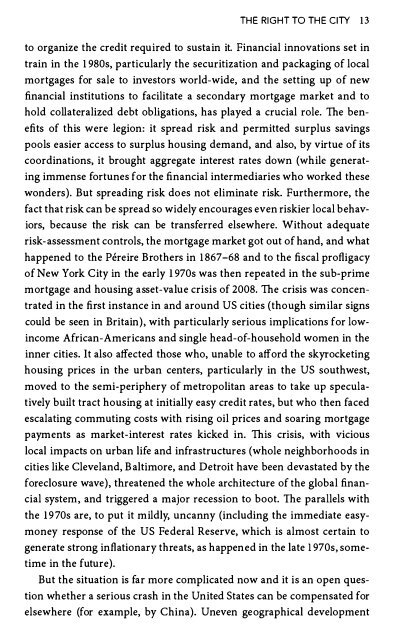Rebel Cities-David Harvey
Rebel Cities-David Harvey
Rebel Cities-David Harvey
- No tags were found...
You also want an ePaper? Increase the reach of your titles
YUMPU automatically turns print PDFs into web optimized ePapers that Google loves.
THE RIGHT TO THE CITY 13to organize the credit required to sustain it. Financial innovations set intrain in the 1980s, particularly the securitization and packaging of localmortgages for sale to investors world-wide, and the setting up of newfinancial institutions to facilitate a secondary mortgage market and tohold collateralized debt obligations, has played a crucial role. The benefitsof this were legion: it spread risk and permitted surplus savingspools easier access to surplus housing demand, and also, by virtue of itscoordinations, it brought aggregate interest rates down (while generatingimmense fortunes for the financial intermediaries who worked thesewonders). But spreading risk does not eliminate risk. Furthermore, thefact that risk can be spread so widely encourages even riskier local behaviors,because the risk can be transferred elsewhere. Without adequaterisk-assessment controls, the mortgage market got out of hand, and whathappened to the Pereire Brothers in 1867-68 and to the fiscal profligacyof New York City in the early 1970s was then repeated in the sub-primemortgage and housing asset-value crisis of 2008. The crisis was concentratedin the first instance in and around US cities (though similar signscould be seen in Britain), with particularly serious implications for lowincomeAfrican-Americans and single head-of-household women in theinner cities. It also affected those who, unable to afford the skyrocketinghousing prices in the urban centers, particularly in the US southwest,moved to the semi-periphery of metropolitan areas to take up speculativelybuilt tract housing at initially easy credit rates, but who then facedescalating commuting costs with rising oil prices and soaring mortgagepayments as market-interest rates kicked in. This crisis, with viciouslocal impacts on urban life and infrastructures (whole neighborhoods incities like Cleveland, Baltimore, and Detroit have been devastated by theforeclosure wave), threatened the whole architecture of the global financialsystem, and triggered a major recession to boot. The parallels withthe 1970s are, to put it mildly, uncanny (including the immediate easymoneyresponse of the US Federal Reserve, which is almost certain togenerate strong inflationary threats, as happened in the late 1970s, sometimein the future).But the situation is fa r more complicated now and it is an open questionwhether a serious crash in the United States can be compensated forelsewhere (for example, by China). Uneven geographical development


